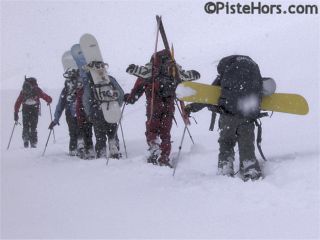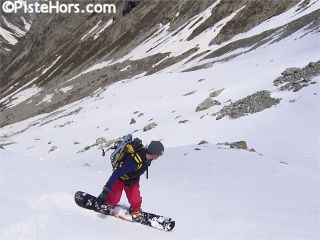
Gear > Backcountry Snowboarding
Let's face it; snowboards were not really made for bumping down hard ski pistes, dodging skiers in bright pink ski suits. They were made either for the snowpark or for gliding across acres of fresh powder, carving wide turns in the virgin snow. Skiers are often amazed at the ease with which boarders can go off piste. An average snowboarder can be riding the backcountry with style after only a few weeks, a level that would take skiers many seasons to master. This is both an advantage, and a danger. Even the most obtuse skier will pick up some ideas about safe travel in the mountains whereas many young, and plenty of older riders are blissfully unaware of the dangers posed by the glistening snow covering the mountains.
Compared to even ten years ago the shear number of freeriders out there means that fresh powder is in short supply in even the biggest stations. After a dump it takes barely a morning for all the visible off piste to be tracked out in resorts like la Grave, Val dIsère or Chamonix. The solution is to either get up at first light with the lifties, or to climb.

Climbing on Snowshoes in the Vanoise
How far you climb really depends on your fitness, knowledge, equipment and any local regulations covering off-piste access. But often you dont need to go far. Most times last season I was able to find untracked snow within 15 minutes of the ski lifts even a week after the last fall.
However when it comes to accessing the backcountry the tables are turned against boarders. Over the years alpine ski touring (AT) and telemark gear has been honed close to perfection. In the case of Alpine touring, the gear is reasonably light and performs almost as well as piste equipment. Skiers can fix skins to the bottom of their skis, flick a lever on the binding and be climbing slopes up to 25 degrees at rates of 400 meters an hour with comparative ease. With special crampons (harscheisen or couteaux) that attach to the binding steeper slopes of hard icy snow can be tackled. Routes such as the beautiful Col des Rochers? at Les Arcs can be reached within an hour from the top of the ski lifts.

Backcountry conditions can vary a lot
To get to the backcountry, boarders have a number of choices, all of them a compromise of sorts: climb on foot, use snowshoes, use approach skis or use a split board. They also have to decide whether to use hard or soft boots.
<< Ski | Gear | Navigation >>